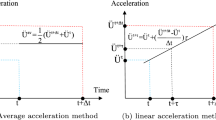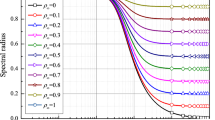Abstract
Finite difference schemes have been widely studied because of their fundamental role in numerical analysis. However, most finite difference formulas in the literature are not suitable for discrete time-varying problems because of intrinsic limitations and their relatively low precision. In this paper, a high-precision 1-step-ahead finite difference formula is developed. This 5-instant finite difference (5-IFD) formula is used to approximate and discretize first-order derivatives, and it helps us to compute discrete time-varying generalized matrix inverses. Furthermore, as special cases of generalized matrix inverses, time-varying matrix inversion, and scalar reciprocals are generally deemed as independent problems and studied separately, which are solved unitedly in this paper. The precision of the 5-IFD formula and the convergence behavior of the corresponding discrete-time models are derived theoretically and shown in numerical experiments. Conventional useful formulas, such as the Euler forward finite difference (EFFD) formula and the 4-instant finite difference (4-IFD) formula are also used for comparisons and to show the superiority of the 5-IFD formula.
Similar content being viewed by others
References
Lu, P., Kampen, E., Visser, C., Chu, Q.: Aircraft fault-tolerant trajectory control using incremental nonlinear dynamic inversion. Control Eng. Pract. 57, 126–141 (2016)
Zhou, F., Jiang, J., Shui, P.: Fast design of 2D fully oversampled DFT modulated filter bank using Toeplitz-block Toeplitz matrix inversion. Signal Process. 111, 194–198 (2015)
Cai, B., Jiang, X.: A novel artificial neural network method for biomedical prediction based on matrix pseudo-inversion. J. Biomed. Inform. 48, 114–121 (2014)
El-Mikkawy, M.E.A.: Inversion of a generalized Vandermonde matrix. Int. J. Comput. Moth. 80, 759–765 (2003)
Evans, D.J.: An implicit iterative process for matrix inversion. Int. J. Comput. Moth. 9, 335–341 (1981)
Vajargah, B.F.: A way to obtain Monte Carlo matrix inversion with minimal error. Appl. Math. Comput. 191, 225–233 (2007)
Petkovic, M.D., Stanimirovic, P.S.: Generalized matrix inversion is not harder than matrix multiplication. J. Comput. Appl. Math. 230, 270–282 (2009)
Che, K., Yi, C.: Robustness analysis of a hybrid of recursive neural dynamics for online matrix inversion. Appl. Math. Comput. 273, 969–975 (2016)
Chen, K.: Recurrent implicit dynamics for online matrix inversion. Appl. Math. Comput. 219, 10218–10224 (2013)
Chawla, M.M., Passi, K., Shivakumar, P.N.: A recursive partitioning algorithm for inverting tridiagonal matrices. Int. J. Comput. Moth. 35, 153–158 (1990)
Margaritis, K.G., Evans, D.J.: Iterative matrix inversion on a systolic array: a case of algorithm integration. Int. J. Comput. Moth. 51, 95–106 (1994)
Sharma, G., Agarwala, A., Bhattacharya, B.: A fast parallel Gauss Jordan algorithm for matrix inversion using CUDA. Comput. Struct. 128, 31–37 (2013)
Amestoy, P.R., Duff, I.S., L’Excellent, J.Y., Rouet, F.H.: Parallel computation of entries of A − 1. SIAM J. Sci. Comput. 37, 268–284 (2015)
Li, S., Li, Y., Wang, Z.: A class of finite-time dual neural networks for solving quadratic programming problems and its k-winners-take-all application. Neural Netw. 39, 27–39 (2013)
Ding, F., Chen, T.: Gradient based iterative algorithms for solving a class of matrix equations. IEEE Trans. Autom. Control 50, 1216–1221 (2005)
Wang, Q.: Theoretical and computational issues of optimal control for distributed Hopfield neural network equations with diffusion term. J. Comput. Appl. Math. 29, 890–911 (2007)
Jin, L., Li, S., Luo, X., Li, Y., Qin, B.: Neural dynamics for cooperative control of redundant robot manipulators. IEEE Trans. Ind. Inf. https://doi.org/10.1109/TII.2018.2789438 (2018)
Jin, L., Li, S., La, H., Luo, X.: Manipulability optimization of redundant manipulators using dynamic neural networks. IEEE Trans. Ind. Electron. 64, 4710–4720 (2017)
Schilders, W.H.A., Meijer, P.B.L., Ciggaar, E.: Behavioural modelling using the MOESP algorithm, dynamic neural networks and the Bartels-Stewart algorithm. Appl. Numer. Math. 58, 1972–1993 (2008)
Xia, Y., Feng, G., Wang, J.: A recurrent neural network with exponential convergence for solving convex quadratic program and related linear piecewise equations. Neural Netw. 17, 1003–1015 (2004)
Liu, Q., Wang, J.: Finite-time convergent recurrent neural network with a hard-limiting activation function for constrained optimization with piecewise-linear objective functions. IEEE Trans. Neural Netw. 22, 601–613 (2011)
Kennedy, M.P., Chua, L.O.: Neural networks for nonlinear programming. IEEE Trans. Circ. Syst. 35, 554–562 (1988)
Zhang, Y., Wang, J.: A dual neural network for convex quadratic programming subject to linear equality and inequality constraints. Phys. Lett. A 298, 271–278 (2002)
Li, S., Li, Y.: Nonlinearly activated neural network for solving time-varying complex Sylvester equation. IEEE Trans. Cybern. 44, 1397–1407 (2014)
Guo, D., Nie, Z., Yan, L.: Theoretical analysis, numerical verification and geometrical representation of new three-step DTZD algorithm for time-varying nonlinear equations solving. Neurocomputing 214, 516–526 (2016)
Jin, L., Li, S.: Distributed task allocation of multiple robots: a control perspective. IEEE Trans. Syst. Man Cybern. Syst. https://doi.org/10.1109/TSMC.2016.2627579 (2017)
Zhang, Y., Ge, S.: Design and analysis of a general recurrent neural network model for time-varying matrix inversion. IEEE Trans. Neural Netw. 16, 1477–1490 (2005)
Miao, P., Shen, Y., Huang, Y., Wang, Y.: Solving time-varying quadratic programs based on finite-time Zhang neural networks and their application to robot tracking. Neural Comput. Appl. 26, 693–703 (2015)
Jin, L., Zhang, Y., Li, S.: Integration-enhanced Zhang neural network for real-time-varying matrix inversion in the presence of various kinds of noises. IEEE Trans. Neural Netw. Learn. Syst. 27, 2615–2627 (2016)
Zhang, Y., Yi, C.: Zhang Neural Networks and Neural-Dynamic Method. Nova, New York (2011)
Xiao, L.: A nonlinearly activated neural dynamics and its finite-time solution to time-varying nonlinear equation. Neurocomputing 173, 1983–1988 (2016)
Guo, D., Lin, X., Su, Z., Sun, S., Huang, Z.: Design and analysis of two discrete-time ZD algorithms for time-varying nonlinear minimization. Numer. Algor. https://doi.org/10.1007/s11075-017-0302-4 (2017)
Jin, L., Zhang, Y.: Continuous and discrete Zhang dynamics for real-time varying nonlinear optimization. Numer. Algor. 73, 115–140 (2016)
Zhang, Y., Li, Z., Guo, D., Ke, Z., Chen, P.: Discrete-time ZD, GD and NI for solving nonlinear time-varying equations. Numer. Algor. 64, 721–740 (2013)
Zhang, Y., Xiao, L., Ruan, G., Li, Z.: Continuous and discrete time Zhang dynamics for time-varying 4th root finding. Numer. Algor. 57, 35–51 (2011)
Zhang, Y., Jin, L., Guo, D., Yin, Y., Chou, Y.: Taylor-type 1-step-ahead numerical differentiation rule for first-order derivative approximation and ZNN discretization. J. Comput. Appl. Math. 273, 29–40 (2014)
Zhang, Y., Chou, Y., Chen, J., Zhang, Z., Xiao, L.: Presentation, error analysis and numerical experiments on a group of 1-step-ahead numerical differentiation formulas. J. Comput. Appl. Math. 239, 406–414 (2013)
Mao, M., Li, J., Jin, L., Li, S., Zhang, Y.: Enhanced discrete-time Zhang neural network for time-variant matrix inversion in the presence of bias noises. Neurocomputing 207, 220–230 (2016)
Liao, B., Zhang, Y.: Different complex ZFs leading to different complex ZNN models for time-varying complex generalized inverse matrices. IEEE Trans. Neural Netw. Learn. Syst. 25, 1621–1631 (2014)
Guo, D., Zhang, Y.: Zhang neural network, Getz-Marsden dynamic system, and discrete-time algorithms for time-varying matrix inversion with application to robots’ kinematic control. Neurocomputing 97, 22–32 (2012)
Getz, N.H., Marsden, J.E.: Dynamical methods for polar decomposition and inversion of matrices. Linear Algebra Appl. 258, 311–343 (1997)
Mathews, J.H., Fink, K.D.: Numerical Methods Using MATLAB. Prentice-hall, Inc, Englewood (2005)
Engeln-Müllges, G., Uhlig, F.: Numerical Algorithms with C. Springer, New York (1996)
Suli, E., Mayers, D.F.: An Introduction to Numerical Analysis. Cambridge University Press, Oxford (2003)
Zhang, Y., Li, F., Yang, Y., Li, Z.: Different Zhang functions leading to different Zhang-dynamics models illustrated via time-varying reciprocal solving. Appl. Math. Modell. 36, 4502–4511 (2012)
Zhang, Y., Ma, W., Cai, B.: From Zhang neural network to Newton iteration for matrix inversion. IEEE Trans. Circ. Syst. Regul. Pap. 56, 1405–1415 (2009)
Funding
The work is supported by the National Natural Science Foundation of China (with numbers 61473323), by the Foundation of Key Laboratory of Autonomous Systems and Networked Control, Ministry of Education, China (with number 2013A07), and also by the Laboratory Open Fund of Sun Yat-sen University (with number 20160209). Kindly note that all authors of the paper are jointly of the first authorship and jointly of the corresponding authorship.
Author information
Authors and Affiliations
Corresponding author
Rights and permissions
About this article
Cite this article
Li, J., Mao, M., Uhlig, F. et al. A 5-instant finite difference formula to find discrete time-varying generalized matrix inverses, matrix inverses, and scalar reciprocals. Numer Algor 81, 609–629 (2019). https://doi.org/10.1007/s11075-018-0564-5
Received:
Accepted:
Published:
Issue Date:
DOI: https://doi.org/10.1007/s11075-018-0564-5




